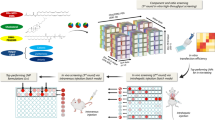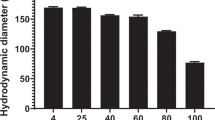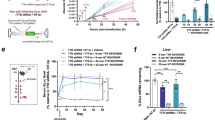Abstract
The intranuclear disposition of exogenous DNA is quite important for the therapeutic effects of the administered DNA. The expression efficiency from one copy of exogenous DNA delivered by hydrodynamics-based injection dramatically decreases over time, and this ‘silencing’ occurs without CpG methylation. In this study, naked luciferase-plasmid DNA was delivered into mouse liver by hydrodynamics-based injection, and modifications of the histones bound to the plasmid DNA were analyzed by a chromatin immunoprecipitation (ChIP) analysis. In addition, the effects of a second hydrodynamics-based injection on the expression from the plasmid DNA were examined. The ChIP analysis revealed that the modification status of histone H3 remained constant from 4 h to 4 weeks. Surprisingly, the injection of saline without DNA enhanced the luciferase expression from the preexisting DNA administered 4 and 14 days previously. Our results suggest that histone modification plays no role in the silencing. Instead, our data suggest that the transgene expression is activated by the hydrodynamics-based injection manipulation, and that the return from the activated status causes the silencing.
This is a preview of subscription content, access via your institution
Access options
Subscribe to this journal
Receive 12 print issues and online access
$259.00 per year
only $21.58 per issue
Buy this article
- Purchase on Springer Link
- Instant access to full article PDF
Prices may be subject to local taxes which are calculated during checkout




Similar content being viewed by others
References
Rolland AP . From genes to gene medicines: recent advances in nonviral gene delivery. Crit Rev Ther Drug Carrier Syst 1998; 15: 143–198.
Kamiya H, Tsuchiya H, Yamazaki J, Harashima H . Intracellular trafficking and transgene expression of viral and non-viral gene vectors. Adv Drug Del Rev 2001; 52: 153–164.
Niidome T, Huang L . Gene therapy progress and prospects: nonviral vectors. Gene Therapy 2002; 9: 1647–1652.
Kamiya H, Akita H, Harashima H . Pharmacokinetic and pharmacodynamic considerations in gene therapy. Drug Discovery Today 2003; 8: 990–996.
Herweijer H, Zhang G, Subbotin VM, Budker V, Williams P, Wolff JA . Time course of gene expression after plasmid DNA gene transfer to the liver. J Gene Med 2001; 3: 280–291.
Chen ZY, He CY, Ehrhardt A, Kay MA . Minicircle DNA vectors devoid of bacterial DNA result in persistent and high-level transgene expression in vivo. Mol Ther 2003; 8: 495–500.
Chen ZY, He CY, Meuse L, Kay MA . Silencing of episomal transgene expression by plasmid bacterial DNA elements in vivo. Gene Therapy 2004; 11: 856–864.
Pringle IA, Raman S, Sharp WW, Cheng SH, Hyde SC, Gill DR . Detection of plasmid DNA vectors following gene transfer to the murine airways. Gene Therapy 2005; 12: 1206–1214.
Ochiai H, Harashima H, Kamiya H . Intranuclear dispositions of exogenous DNA in vivo: silencing, methylation and fragmentation. FEBS Lett 2006; 580: 918–922.
Ochiai H, Harashima H, Kamiya H . Silencing of exogenous DNA in cultured cells. Biol Pharm Bull 2006; 29: 1294–1296.
Alino SF, Crespo A, Dasi F . Long-term therapeutic levels of human alpha-1 antitrypsin in plasma after hydrodynamic injection of nonviral DNA. Gene Therapy 2003; 10: 1672–1679.
Stoll SM, Sclimenti CR, Baba EJ, Meuse L, Kay MA, Calos MP . Epstein–Barr virus/human vector provides high-level, long-term expression of α1-antitrypsin in mice. Mol Ther 2001; 4: 122–129.
Yew NS, Zhao H, Przybylska M, Wu IH, Tousignant JD, Scheule RK et al. CpG-depleted plasmid DNA vectors with enhanced safety and long-term gene expression in vivo. Mol Ther 2002; 5: 731–738.
Hodges BL, Taylor KM, Joseph MF, Bourgeois SA, Scheule RK . Long-term transgene expression from plasmid DNA gene therapy vectors is negatively affected by CpG dinucleotides. Mol Ther 2004; 10: 269–278.
Brooks AR, Harkins RN, Wang P, Qian HS, Liu P, Rubanyi GM . Transcriptional silencing is associated with extensive methylation of the CMV promoter following adenoviral gene delivery to muscle. J Gene Med 2004; 6: 395–404.
Loser P, Jennings GS, Strauss M, Sandig V . Reactivation of the previously silenced cytomegalovirus major immediate-early promoter in the mouse liver: involvement of NF-kappaB. J Virol 1998; 72: 180–190.
Strahl BD, Allis CD . The language of covalent histone modifications. Nature 2000; 403: 41–45.
Ebert A, Lein S, Schotta G, Reuter G . Histone modification and the control of heterochromatic gene silencing in Drosophila. Chromosome Res 2006; 14: 377–392.
Pannell D, Ellis J . Silencing of gene expression: implications for design of retrovirus vectors. Rev Med Virol 2001; 11: 205–217.
Mutskov V, Felsenfeld G . Silencing of transgene transcription precedes methylation of promoter DNA and histone H3 lysine 9. EMBO J 2004; 14: 138–149.
Janicki SM, Tsukamoto T, Salghetti SE, Tansey WP, Sachidanandam R, Prasanth KV et al. From silencing to gene expression: real-time analysis in single cells. Cell 2004; 116: 683–698.
Liu F, Song Y, Liu D . Hydrodynamics-based transfection in animals by systemic administration of plasmid DNA. Gene Therapy 1999; 6: 1258–1266.
Zhang G, Budker V, Wolff JA . High levels of foreign gene expression in hepatocytes after tail vein injections of naked plasmid DNA. Hum Gene Ther 1999; 10: 1735–1737.
Reeves R, Gorman CM, Howard B . Minichromosome assembly of non-integrated plasmid DNA transfected into mammalian cells. Nucleic Acids Res 1985; 13: 3599–3615.
Eberhardy SR, D'Cunha CA, Farnham PJ . Direct examination of histone acetylation on Myc target genes using chromatin immunoprecipitation. J Biol Chem 2000; 275: 33798–33805.
Scribner KB, McGrane MM . RNA polymerase II association with the phosphoenolpyruvate carboxykinase (PEPCK) promoter is reduced in vitamin A-deficient mice. J Nutr 2003; 133: 4112–4117.
Herweijer H, Wolff JA . Gene therapy progress and prospects: hydrodynamic gene delivery. Gene Therapy 2007; 14: 99–107.
Kobayashi N, Nishikawa M, Takakura Y . The hydrodynamics-based procedure for controlling the pharmacokinetics of gene medicines at whole body, organ and cellular levels. Adv Drug Deliv Rev 2005; 57: 713–731.
Al-Dosari M, Zhang G, Knapp JE, Liu D . Evaluation of viral and mammalian promoters for driving transgene expression in mouse liver. Biochem Biophys Res Commun 2006; 339: 673–678.
Suda T, Gao X, Stolz DB, Liu D . Structural impact of hydrodynamic injection on mouse liver. Gene Therapy 2007; 14: 129–137.
Zhang G, Gao X, Song YK, Vollmer R, Stolz DB, Gasiorowski JZ et al. Hydroporation as the mechanism of hydrodynamic delivery. Gene Therapy 2004; 11: 675–682.
Andrianaivo F, Lecocq M, Wattiaux-De Coninck S, Wattiaux R, Jadot M . Hydrodynamics-based transfection of the liver: entrance into hepatocytes of DNA that causes expression takes place very early after injection. J Gene Med 2004; 6: 877–883.
Crespo A, Peydro A, Dasi F, Benet M, Calvete JJ, Revert F et al. Hydrodynamic liver gene transfer mechanism involves transient sinusoidal blood stasis and massive hepatocyte endocytic vesicles. Gene Therapy 2005; 12: 927–935.
Alino SF, Herrero MJ, Noguera I, Dasi F, Sanchez M . Pig liver gene therapy by noninvasive interventionist catheterism. Gene Therapy 2007; 14: 334–343.
Morral N, Parks RJ, Zhou H, Langston C, Schiedner G, Quinones J et al. High doses of helper-dependent adenoviral vector yield supraphysiological levels of α1-antitrypsin with negligible toxicity. Hum Gene Therapy 1998; 9: 2709–2716.
Dasi F, Benet M, Crespo J, Crespo A, Alino SF . Asialofetuin liposome-mediated human α1-antitrypsin gene transfer in vivo results in stationary long-term gene expression. J Mol Med 2001; 79: 205–212.
Miao CH, Ohashi K, Patijn GA, Meuse L, Ye X, Thompson AR et al. Inclusion of the hepatic locus control region, an intron, and untranslated region increases and stabilizes hepatic factor IX gene expression in vivo but not in vitro. Mol Ther 2000; 1: 522–532.
Nishikawa J, Amano M, Fukue Y, Tanaka S, Kishi H, Hirota Y et al. Left-handedly curved DNA regulates accessibility to cis-DNA elements in chromatin. Nucleic Acids Res 2003; 31: 6651–6662.
Kamiya H, Fukunaga S, Ohyama T, Harashima H . The location of the left-handedly curved DNA sequence affects exogenous DNA expression in vivo. Arch Biochem Biophys 2007; 461: 7–12.
Acknowledgements
This work was supported in part by Grants-in-Aid from the Ministry of Education, Culture, Sports, Science and Technology of Japan, and the Japan Society for the Promotion of Science.
Author information
Authors and Affiliations
Corresponding author
Additional information
Supplementary Information accompanies the paper on Gene Therapy website (http://www.nature.com/gt)
Supplementary information
Rights and permissions
About this article
Cite this article
Ochiai, H., Fujimuro, M., Yokosawa, H. et al. Transient activation of transgene expression by hydrodynamics-based injection may cause rapid decrease in plasmid DNA expression. Gene Ther 14, 1152–1159 (2007). https://doi.org/10.1038/sj.gt.3302970
Received:
Revised:
Accepted:
Published:
Issue Date:
DOI: https://doi.org/10.1038/sj.gt.3302970
Keywords
This article is cited by
-
A designed curved DNA sequence remarkably enhances transgene expression from plasmid DNA in mouse liver
Gene Therapy (2012)
-
Inhibition of nuclear delivery of plasmid DNA and transcription by interferon γ: hurdles to be overcome for sustained gene therapy
Gene Therapy (2011)
-
Positive Correlation Between the Generation of Reactive Oxygen Species and Activation/Reactivation of Transgene Expression After Hydrodynamic Injections into Mice
Pharmaceutical Research (2011)
-
Duration of Expression and Activity of Sleeping Beauty Transposase in mouse liver following hydrodynamic DNA delivery
Molecular Therapy (2010)



